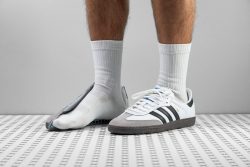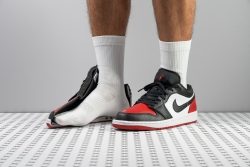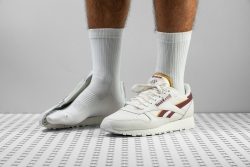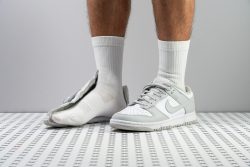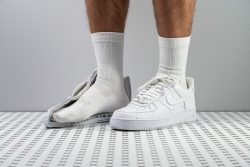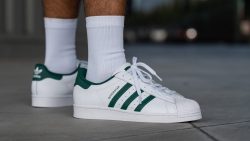7 Best Leather Trainers
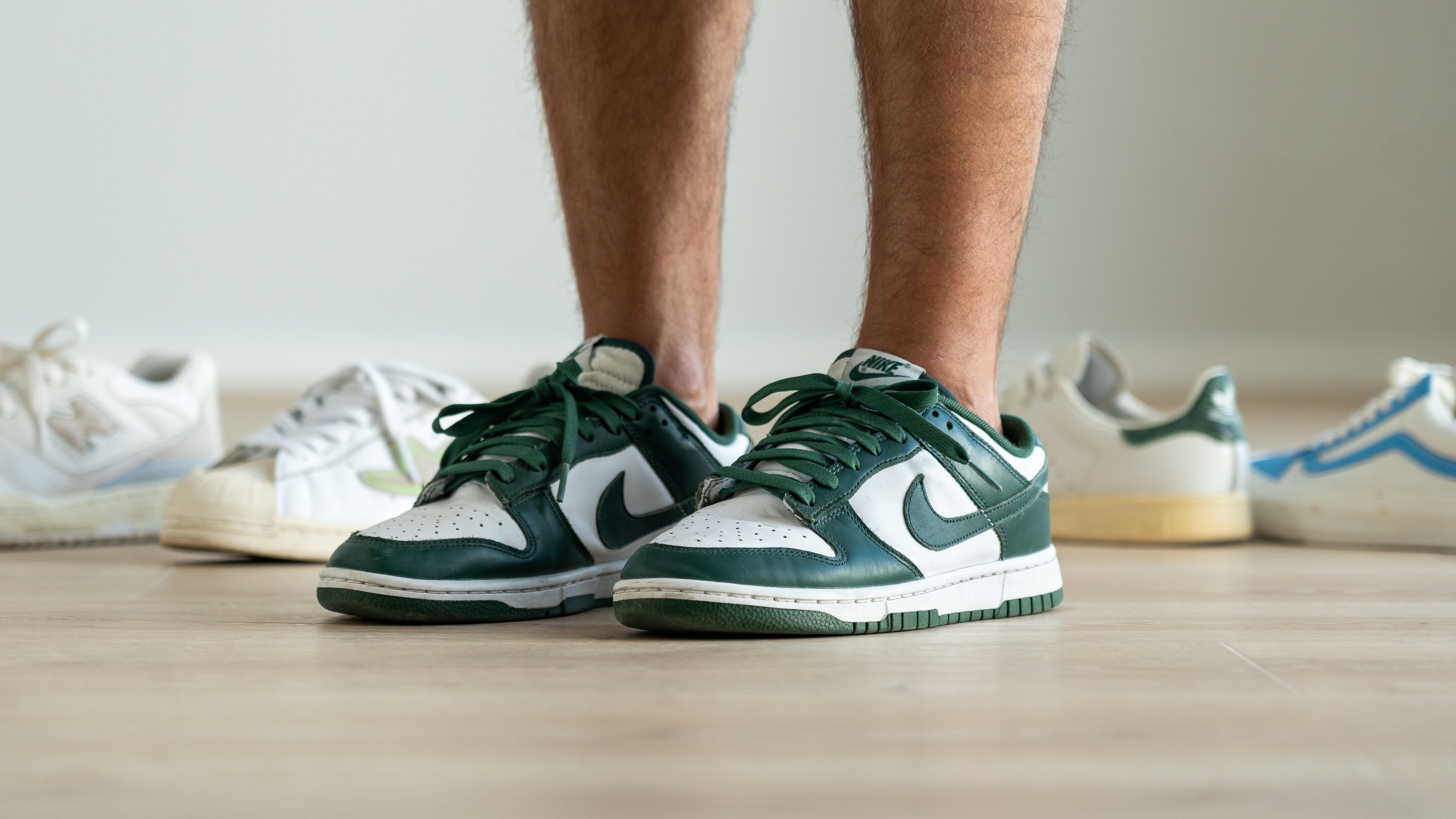
We buy shoes ourselves. We earn commissions when you buy through us, at no extra cost. Why trust us
If you're on the hunt for trainers that get even better as you wear them, leather trainers are your best bet. With so many leather trainers available, finding the best one without reading hundreds of reviews is not easy.
Whether you're new to the sneaker world or planning to add another leather kick to your collection, we're here to help you out. We have spent hours scrutinising leather kicks by wearing them daily and testing them in our lab. We showcase several recommendations for you here.
How we test trainers
To give you honest and fair reviews, here is our approach:
- We buy the leather trainers using our own money to stay unbiased. Does not matter how cheap or expensive they are.
- We thoroughly wear-test these trainers to check their comfort, durability, stability, support, breathability.
- We do a series of lab tests on them. The most important one for leather trainers is the leather quality test, where we burn the leather to test whether it's genuine or fake. We don't stop there, so we cut the trainers in half and measure their stack heights, softness, tongue thickness, and 15+ more features.
- We select the best leather trainers across different categories based on everything we've experienced in and with the trainers.
Best leather trainers overall























































What makes it the best?
The Adidas Samba OG was made of the real thing, honey! We did the fire test, and the material took all the flames in without breaking or crumbling. Well, yeah, it was discoloured, but it remained intact! And the smell of burning hair or flesh was not to be overlooked! Aside from its leather realness, this Adidas sneaker also delivered immense durability and out-of-this-world flexibility, enough for us to crown this as the queen of all leather trainers.
We subjected both the leather toebox and the padded collar to some serious Dremel drilling. Both displayed so much abrasion resistance. Both areas only looked dishevelled at best (or should it be ‘worst’?) when we were done with them. A perfect 5 for durability! Anything lower than that would be illegal!
Just because this shoe showed so much abrasion resistance didn’t mean it would be stiff and unrelenting. Quite on the contrary, this leather sneaker would put Shakira’s hips to shame, honey! It was nearly twice as flexible as the typical sneaker. Bending the Adidas Samba OG would require only 11.7N, while the average kick would require as much as 23.2N.
Too bad this shoe wasn’t as breathable as we needed it to be. It only got a disappointing 2 out of 5 in our breathability assessments.
Pros
- Premium-quality and genuine materials
- Long-lasting design
- Lightweight and flexible
- Comfortable for all-day wear
- A lot of ground feel
- Easy to slip-on
- Great all-rounder
- Iconic 90s style
- It has eco-friendly versions
- Worth the price
Cons
- Slightly narrow and tight
- Lacks arch support
Best classic leather trainers

























































What makes it the best?
The Air Jordan 1 Low effortlessly blends its iconic heritage with timeless style, serving athleticism and fashion in one shoe. This pair, and the whole Jordan line, is a testament to Michael Jordan's golden era with the Chicago Bulls. From a basketball shoe, AJ 1 Low is now a wardrobe staple and our best classic leather sneaker. Beyond looks, this pair offers a stable ride and a long-lasting build, proven by our lab.
Highlighted in its name, the AJ 1 Low maintains a low profile with a stack height of 22.9/11.8 mm vs. the average of 30.0/19.1 mm. This gives us more control over sudden shifts in movement, further supported by the reliable grip of the outsole across various surfaces. The stability it offers reflects its basketball heritage.
The AJ 1 Low's construction demonstrates remarkable resilience, enduring our rigorous Dremel test with minimal damage. It scored a remarkable 4/5 for durability in both the toebox and heel and exhibited 20.0% less wear than the average outsole. Additionally, our blowtorch test confirms the authenticity of the leather in high-wear areas like the heel overlay and eyestay layer.
However, one drawback is its less accommodating toebox, measuring 72.5 mm in the big toe area compared to the 74.8 mm average. This may feel restrictive for those with wider feet.
Pros
- Legendary silhouette
- Adds +1000 points to style
- Fantastic wear resistance
- Very firm and grounded platform
- A Zoom Air unit adds a touch of bounce
- Very secure foothold
- Excellent value for money
- True to size
Cons
- Leather creases easily
- Takes a while to break in
- Not for all-day wear
- Not for all-day wear
Best retro leather trainers
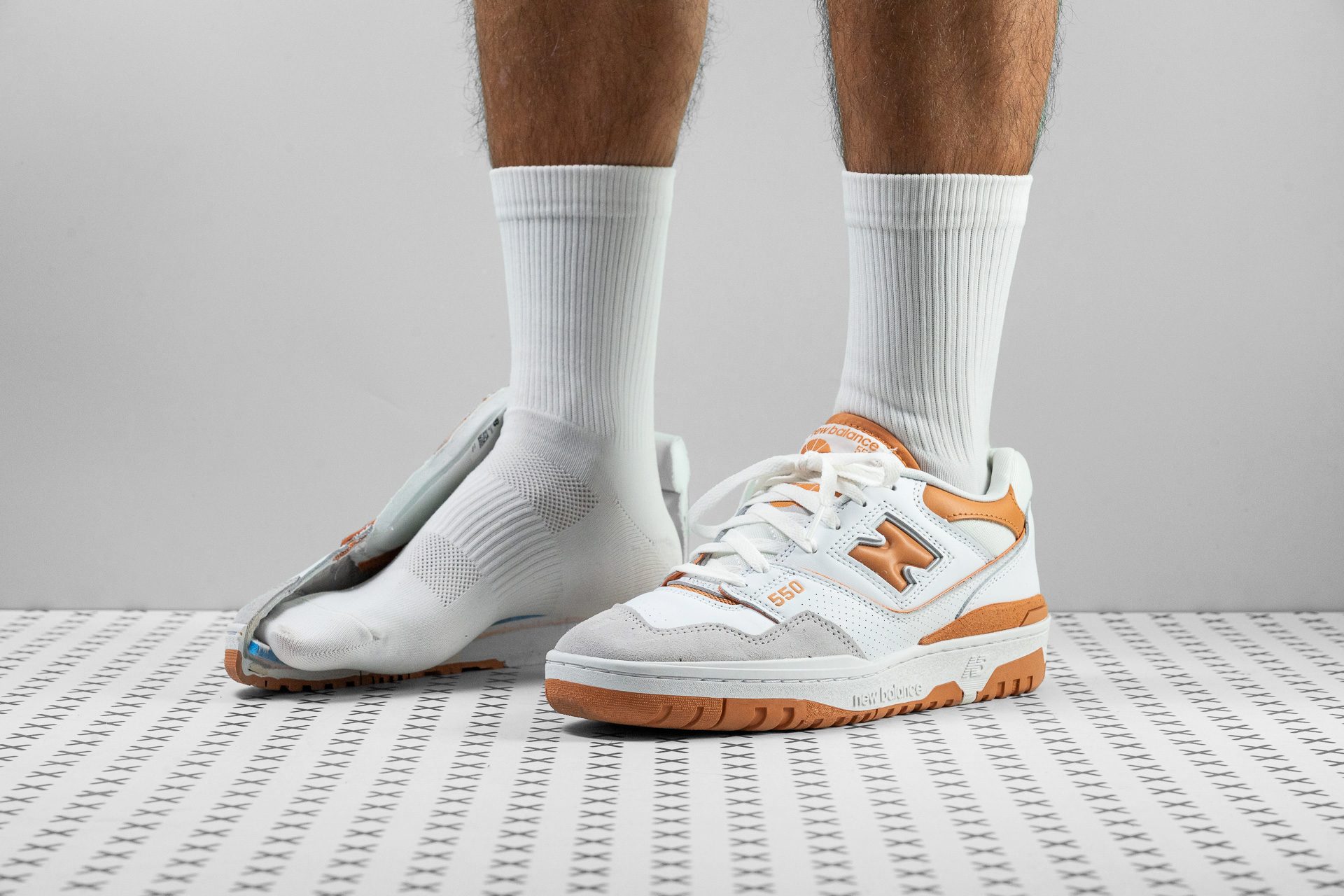










































What makes it the best?
Significant portions of the New Balance 550’s upper were made of real leather, and we couldn’t be more excited about that! Aside from providing durability and structure, the leather made this shoe such a pleasure to see. It retained much of the attributes of the OG 550 so our retro-loving hearts flutter. We also loved that the shoe had an unusually thick insole for dependable arch support. The best retro leather sneaker, indeed!
We torched the overlays on the upper, and then removed the charred surfaces with our awl. We saw that it did not really burn, leading to conclude the genuineness of the leather used.
The leather became soft and flexible over time, but it never lost its durability. Our Dremel was only able to smoothen out the velvety overlay on the toe box, but it never got to cause real damage. The 4 over 5 score that we gave was truly well-deserved.
Based on our calliper readings, the insole was 8.8 mm thick. The insole used in the NB 550 was a lot thicker than average, which was recorded to be only 5.4 mm thick. In addition to providing underfoot pampering, this soft insert also delivered arch support.
Wide-footers, however, couldn’t enjoy this shoe. The toebox was just too narrow for them. At the big toe, this shoe was only 71.2 mm wide. The average width of this part was 75.2 mm.
Pros
- Attention-grabbing throwback look
- Well-cushioned insole
- Incredibly clean details
- Suitable for various outfits
- Durable, high-quality construction
- No visible wear after several uses
- Easy to clean
- Striking shades
- Reasonably priced
Cons
- Insufficient lockdown feel
- Released in a limited quantity
- Released in a limited quantity
Best lightweight leather trainers
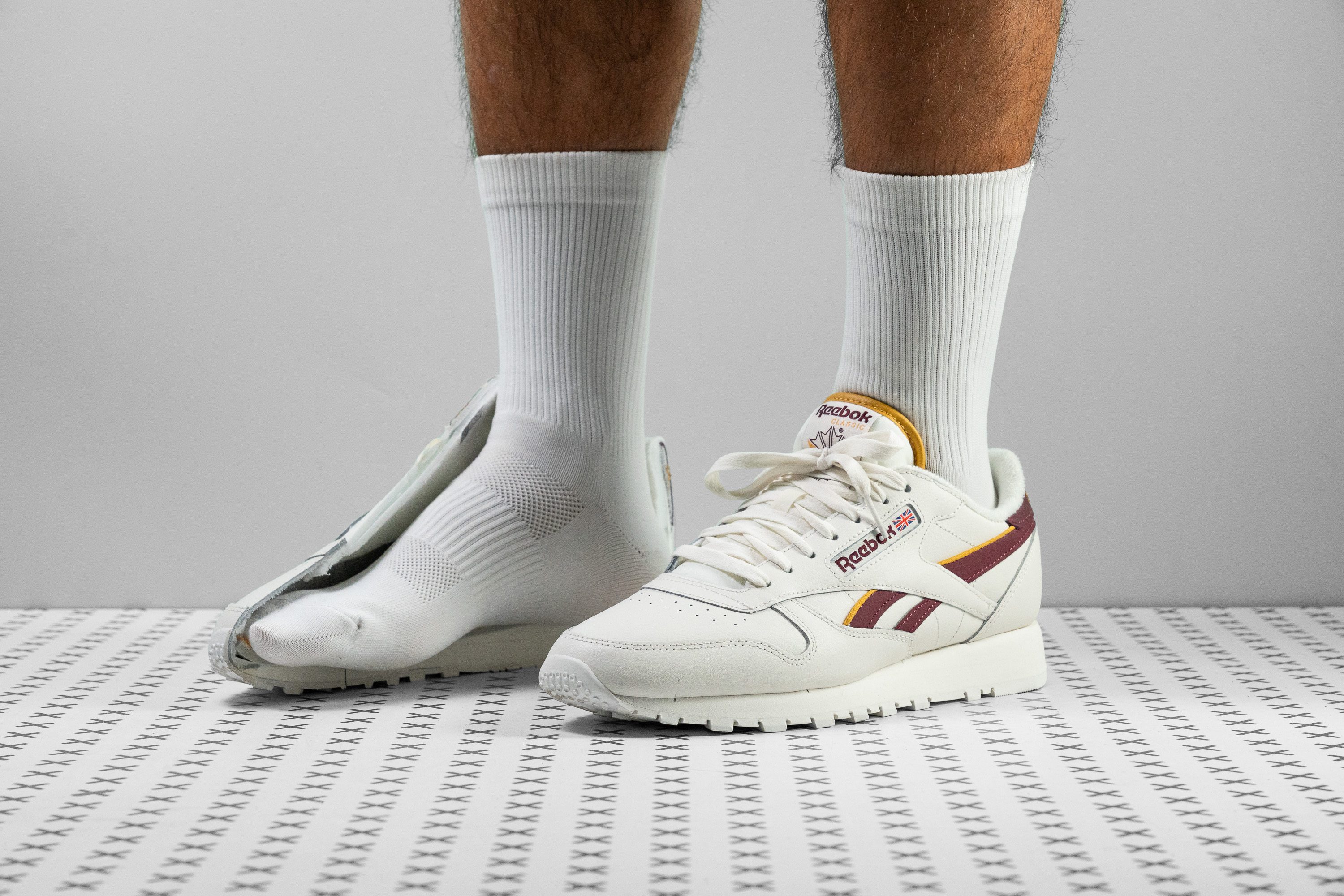







































What makes it the best?
The Reebok Classic Leather delivered an amazingly reliable heel hold. Aside from that, it also provided us with a thicker-than-average midsole that was effective in neutralising impact. Still, this shoe still managed to keep its weight low and nice. Having been able to make the most out of every ounce of its weight, we hail the Reebok Classic Leather as the best lightweight leather sneaker in our inventory.
In our lab, we gave the heel counter a good squeeze to test its ability to provide much needed support and responsiveness. It passed with flying colours, garnering a score of 4 out of 5 from us. True enough, it was able to hold its own even when our movements became a bit more aggressive than usual.
Based on our calliper measurements, the midsole of the Reebok Classic Leather was on the thicker side. At the forefoot, it was 22.1 mm (ave 20.0 mm) thick. Its heel stack was as high as 35.7 mm (ave 31.3 mm). The thick midsole not only provided impact protection, it also made us feel and look taller.
What amazed us the most was the shoe’s weight. It still managed to be light at 11.39 ounces (323 grammes) while providing all the goodness that we just described. The average weight for trainers was 14.04 oz or 398 grammes. This was such a feat!
We just wish this sneaker were a bit more breathable. It only got a disappointing 2 out of 5 in our breathability assessments.
Pros
- Mighty plush
- Great investment
- Leader of the pack
- Supportive
- Aesthetically well-rounded
- Enduring
- Affordable
Cons
- Downgraded upper
- Dirt-magnet
Best practical leather trainers
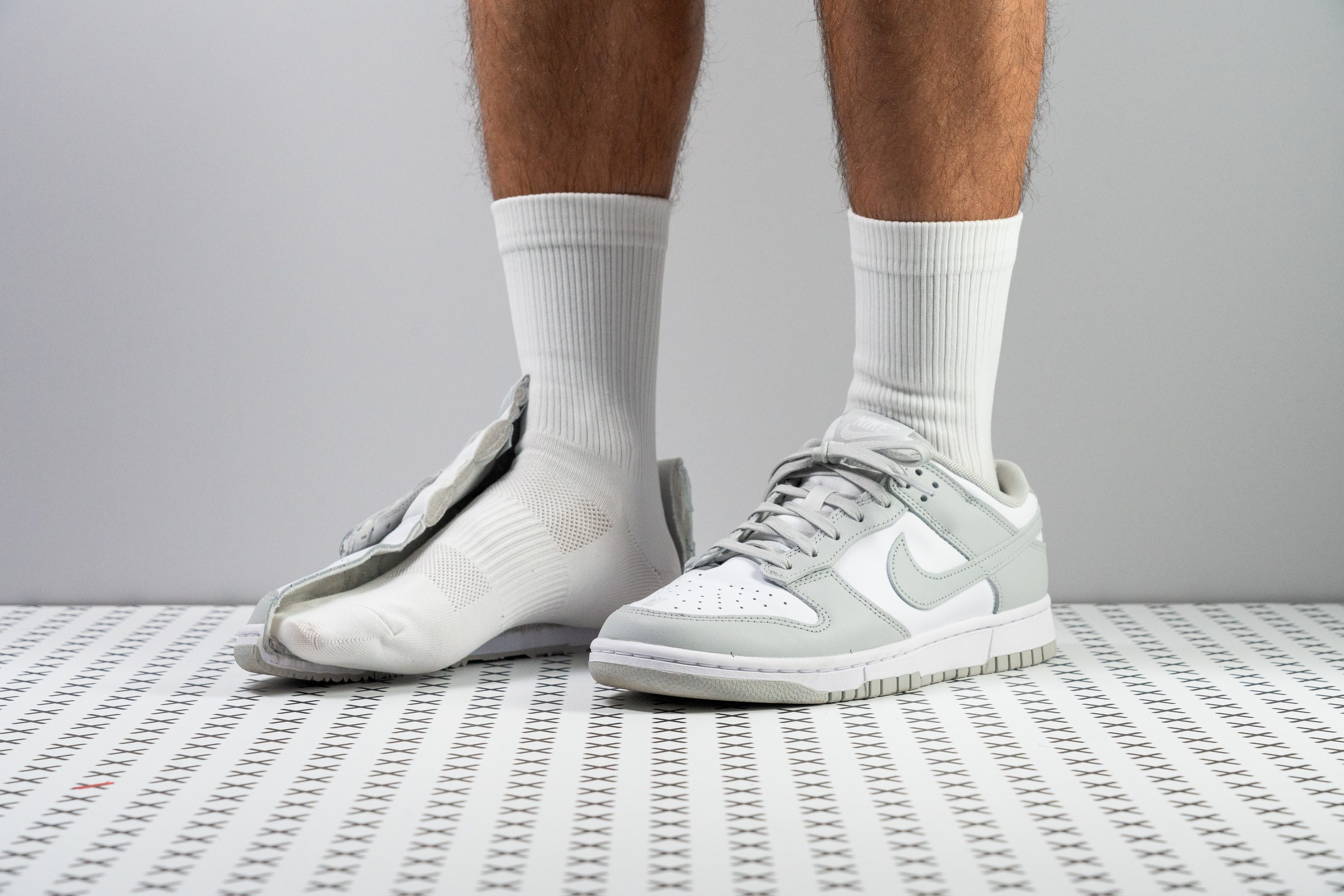





















































What makes it the best?
The Nike Dunk Low evolved from a basketball shoe to a closet mainstay. Its classic silhouette and all-leather (or suede) construction make it versatile for various outfits and occasions, making it our most practical leather sneaker. It provides impressive support with its low profile and grippy outsole at only £90 vs. our lab's £110 average leather sneaker.
Available in numerous colorways, the Dunk Low has been a wardrobe staple for decades. Beyond looks, its premium construction proved genuine in our lab. We verified the upper panels, top overlays, and Swoosh logo using our butane torch and leather scratch awl and they all remained intact. Its high quality shined further in our Dremel test with a 4/5 toebox durability score.
Tracing back to its roots, it maintains a low profile and a firm 32.0 HA platform for enhanced ground feel and better control over our footwork. Additionally, its grippy base kept us safe even on slippery surfaces.
However, we find that it still lacks comfort for extended periods on foot. Those who prefer more cushioning should check for more supportive options.
Pros
- Retro basketball aesthetics
- Real leather (suede) upper
- Excellent durability for the price
- Low and grounded platform (loved by skaters)
- Very stable and supportive
- Surprisingly flexible in the forefoot
- True to size and fit
- Extra eyelets
Cons
- Needs breaking in
- Firm and rigid sole
- Not for all-day wear
Leather trainers with the best style
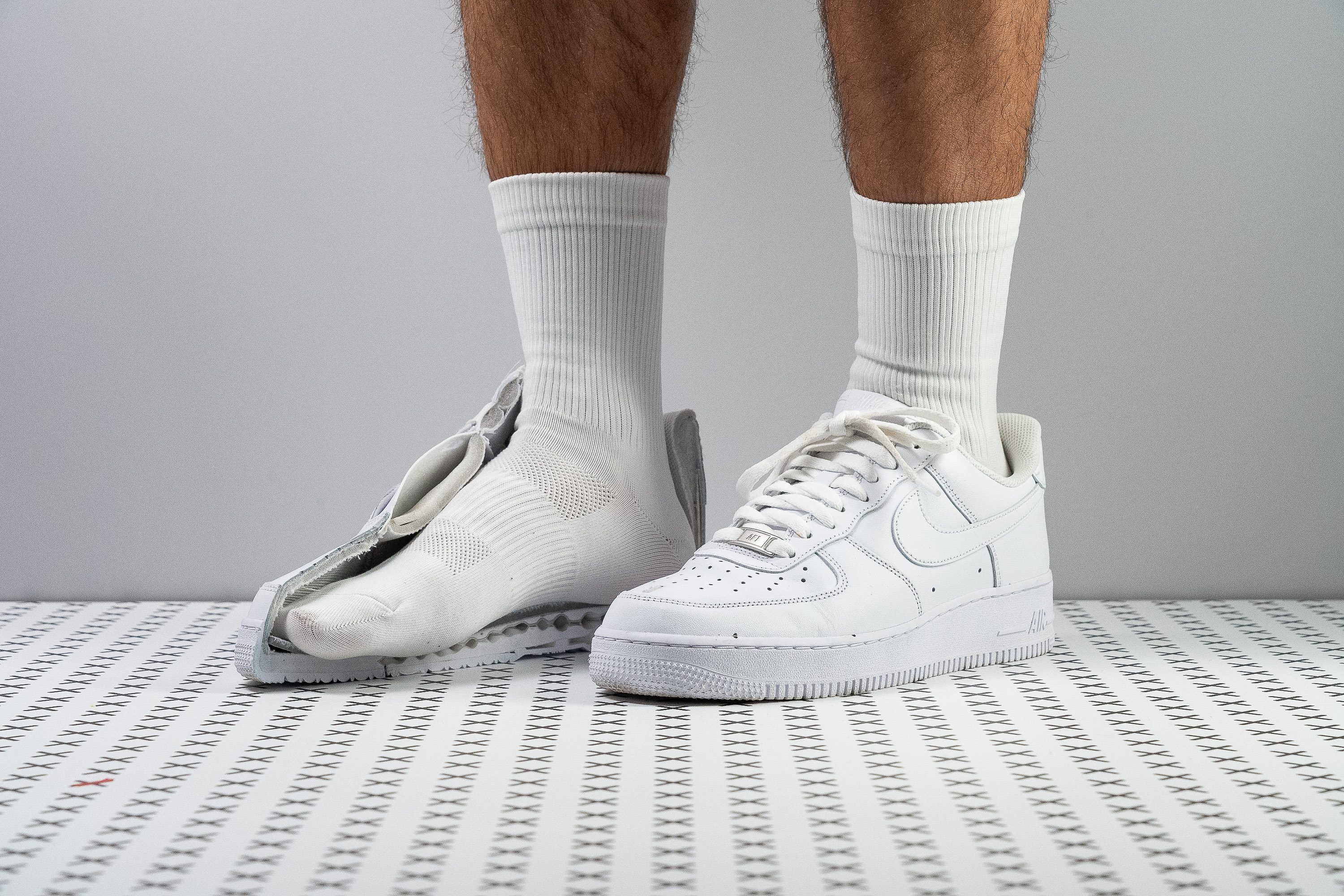


















































What makes it the best?
With its legendary roots and crisp and clean all-leather profile, Nike’s Air Force 1 07 is effortlessly classy. Its iconic silhouette has transitioned seamlessly from the basketball courts to the streets and runways with its versatile appeal. Plus, its sturdy construction delivers stability and durability. Since its release in the 80s, it hasn’t gone out of trend, making it our most stylish leather sneaker in the lab.
The leather upper not only exudes style but also offers excellent protection. Our torch test confirmed its genuineness as the major panels didn’t melt away. Meanwhile, the toebox fought our Dremel persistently, earning a 5/5 durability rating.
Structured and rigid, the midsole holds us firmly in place. We found it difficult to pinch the heel and twist the shoe, maxing out the stiffness score in our manual assessments. Proving its unwavering nature, it even emerged 40.7% stiffer than average in our bend test.
The hard-shell construction and moderate stack enhanced our balance. The platform includes an Air Max unit within a soft 20.9 HA foam to add cushioning. However, these elements are inside a solid construction, leading to a firm and steady ride.
However, the shoe feels like a brick with its stiffness and heavy weight. Those who prioritise comfort over fashion should look elsewhere.
Pros
- Crisp and classic look
- Can be dressed up or down
- Great leather quality for the price
- Responsive Air cushioning
- Highly stable and supportive
- Decent airflow for a leather shoe
- Reasonably priced
- Can last for years
Cons
- Quite heavy
- Creases easily
- Not for all-day wear
- Arduous break-in period
There’s nothing quite like a quality pair of leather trainers, and rightly so - if you know, you know. Famously popular for their combination of comfort, style, and retro good looks, the fact that a good pair of leather trainers makes for the perfect match with so many outfits is just the cherry on top.
In this article, we're going to put the hype and marketing jargon to one side and explore what truly makes leather trainers a top choice for fashion-conscious individuals and practical wearers alike. We’ll also take a look at the behind-the-scenes factors that manufacturers consider, and focus on what really makes the best leather trainers.
How we define leather trainers
At the core, leather trainers are characterised by their primary construction material, which is genuine leather. However, be aware that not all leather trainers are created equal. Quality varies based on the type of leather used, its treatment, and the manufacturing arm behind each pair. Additionally, not all leather trainers are 100% full leather; often there is a blend with some synthetics.
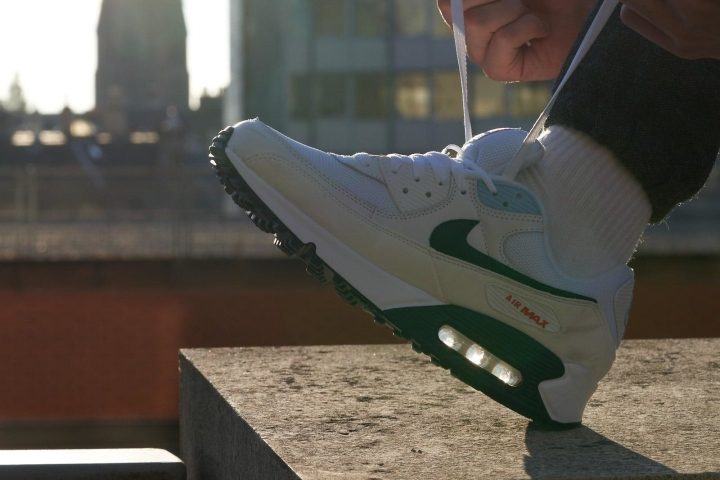
Trainers that are not made of real leather, for example, those that are made from ‘synthetic leather’, are noted accordingly.
Types of leather used for trainers
Most leather used in trainers originates from cowhides, and the quality of the end material depends on these three factors:
- The part of the hide that is used - with the butt and back considered the finest quality, and
- The layer of leather - with the top layer being the best for shoes, and
- Any treatment or tanning modifications that the leather has been subjected to.
Broadly these are then categorised as follows:
Full-grain leather
Full-grain leather is considered the highest quality. It’s derived from the top layer of the hide and retains the grain pattern, making it incredibly durable. It also looks brilliant both from a distance and up close.
For the sake of clarity it’s important to remember that all full-grain leathers are ‘Genuine Leathers’, but not all ‘Genuine Leathers’ are full-grain (or even top-grain).
Top-grain leather
Top-grain leather is slightly thinner than full-grain and has a smoother surface. Its sleek and polished look is often associated with dressy trainers.
Nubuck
Nubuck is a type of full-grain leather that has been sanded down to create a soft, almost velvet-like surface. A favourite amongst those looking for a laid-back, stylish but casual look. Nubuck is made from the tougher, exterior layer of the hide and is therefore stronger than suede.
Nubuck trainers have somewhat of a working-man appeal and are for those with an outdoorsy personality.
Suede
Suede is a high-quality form of leather, made from the underside of the animal hide. It's characterised by a soft smooth surface that looks similar to nubuck but is cheaper to make. Suede is often used in skate shoes, where their excellent grip, maximum comfort, and exceptional durability is highly regarded.
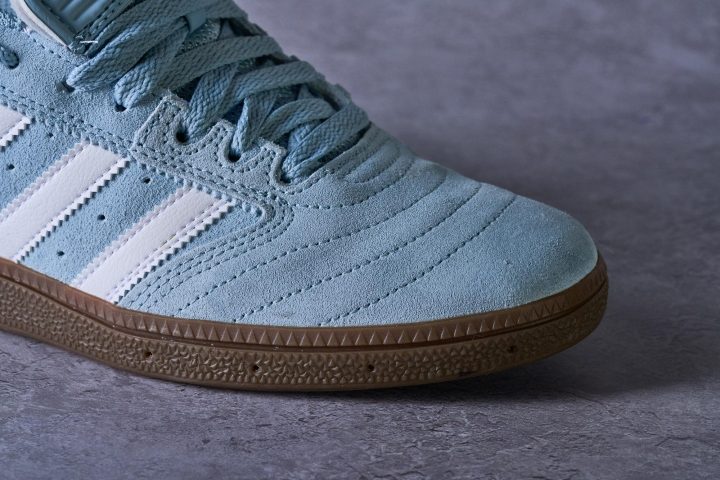
10 reasons why leather matters
1. Breathability: Leather may not "breathe" in the same way humans do, but it does allow air to pass through. This inherent quality keeps your feet cool and prevents unpleasant odours, making leather shoes an excellent choice for foot comfort.
2. Durability: Genuine leather shoes are known for their outstanding durability. They outlast synthetic options, making them a smart investment. You may pay more upfront, but in the long run, you'll likely save by not having to replace them as frequently.
3. Water resistance: Treated or waxed leather becomes resistant to water and other liquids. This is particularly valuable when working in wet environments or kitchens, as it keeps your feet dry and protects your shoes from external damage.

4. Extra protection: While not at the same level as steel-toe cap shoes, leather trainers do offer a natural strength that can provide additional protection from situations such as hot liquid spills or small falling objects, making them a clever but practical choice for many different work environments.
5. Better fit: Leather shoes mould to the shape of your feet over time, offering a customised fit. Unlike synthetic shoes that can feel rigid, leather adapts to your foot shape, enhancing long-term comfort and support.
6. Comfort: Leather is not only durable but also naturally comfortable. And while comfort is an obviously positive trait, it also provides the support your feet need, which is crucial for avoiding sore feet and even back problems.
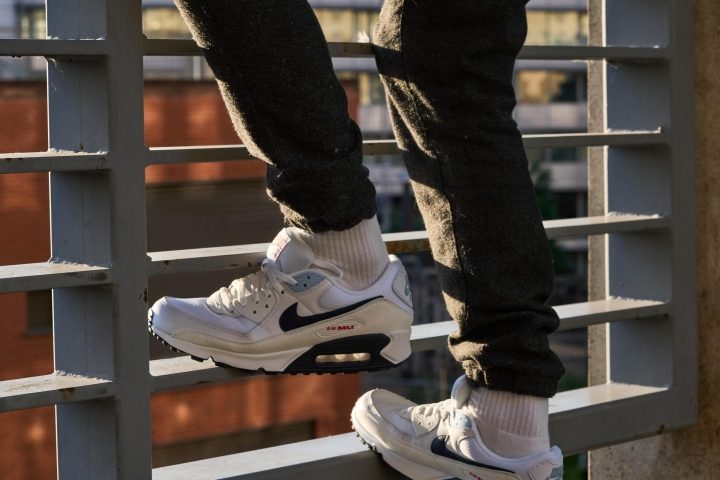
7. Easy to clean: Leather is easy to clean with a damp cloth, and its breathability facilitates quick drying. Proper care ensures your leather products last, making maintenance hassle-free.
8. Simply stylish: Genuine leather trainers are almost always of a classic, stylish appearance. Unlike regular trainers, they add a touch of class to your outfit giving you a sleek, yet trendy, look.
9. Eco-friendly (in a way): Leather is a natural material and therefore eco-friendly. Unlike its synthetic siblings, leather doesn’t involve the use of harmful chemicals during manufacturing.
10. Pleasant scent: Genuine leather has an addictive natural smell to it, one which draws your nose in followed by the mandatory “ahhhh” exhale of satisfaction. You don’t get that on synthetics, often quite the opposite.
Leather vs. synthetic
Let’s take a look at the real-world differences between the two:
|
Leather Trainers |
Synthetic Trainers |
|
|
Durability |
Renowned for durability and longevity. |
May wear out faster, requiring more frequent replacements |
|
Breathability |
Natural breathability which keeps feet cool and mostly odour-free. |
Often less breathable, potentially less comfortable on long days. |
|
Fit |
Tends to adapt to your foot shape over time, creating a personalised custom fit. |
Feels more rigid and doesn’t adapt as well. |
|
Style |
Can be worn to compliment a large variety of outfits in a range of different settings and situations. |
Appears less sophisticated and is generally suited for casual settings only. |
|
Sustainability |
Can be eco-friendly but only when produced responsibly and avoiding harmful chemical additives. |
Less environmentally friendly as it can use toxic chemicals and release harmful gases during the manufacturing process, as well as being more likely to be replaced more frequently. |
|
Price |
Tend to be more expensive up front. |
More budget-friendly initially, but may be less cost effective in the long term due to frequent replacements. |
3 iconic leather sneaker brands
Nike
When Nike releases a new pair of leather trainers, heads turn. From athletic fields to urban streets, Nike’s huge contribution to sneaker culture cannot be ignored.

Adidas
With its iconic three stripes, there’s no question that Adidas is a leader of quality leather athletic footwear. From the retro Stan Smiths of yesteryear to today’s symbols of style, Adidas leather trainers are a classic.

Reebok
With a commitment to quality and designs that last the test of time, Reebok has a strong following in the world of leather trainers - and for good reason: sneakerheads and casual wearers appreciate the attention to detail found in Reebok products.

Make comfort normal again
It’s long been said that leather is more comfortable, but why is that? The unique ability of leather to adapt and conform to your foot's shape creates a customised fit that reduces the need for "breaking-in" periods. So, whether you're dressing up or keeping it casual, leather trainers are in many respects the epitome of comfort, making it the new normal in your daily routine.
The role of the outsole
The outsole of leather trainers is in many respects the foundation of the shoe - responsible for providing traction and grip across a variety of surfaces. It needs to be durable and withstand the elements, while remaining comfortable and looking good. The outsoles of leather trainers tend to be made of rubber.
Is leather sustainable
As the world pursues a more eco-conscious attitude, there are several quite reasonable concerns consumers have when it comes to using leather for materials for not just trainers but also bags, watchbands, sports equipment and furniture. Let’s take a look at the pros and cons for each argument:
Pros of using leather
- Natural: Leather is sourced from animal hides, which means it is a renewable and fully biodegradable resource. Farms over factories.
- Biodegradability: Leather trainers are biodegradable. When discarded, they break down naturally over time, reducing long-term environmental impact compared to non-biodegradable synthetic materials.
- Responsible sourcing and production methods: The leather used in trainers by the big brands is sourced responsibly from suppliers committed to sustainable and ethical practises, which can help protect ecosystems and animal welfare. Advances in tanning technology are exploring more eco-friendly and less chemical-intensive methods, which can decrease the environmental impact of leather production.
- Durability: Leather trainers are known to last, and their longevity will almost always beat their synthetic rivals. In other words, people will dispose of leather trainers many years after they dispose of their regular synthetic trainers. With less ‘fast fashion’ comes less waste, therefore trickling up to a more sustainable world.
Cons for using leather
- Environmental impact: Leather production comes from the livestock industry, and it is this cattle farming that is a significant contributor to greenhouse gas emissions which are known to drive climate change.
- Chemical usage: Traditional tanning processes involve the use of chemicals, some of which can be harmful to the environment if not properly managed, posing potential pollution risks.
- Water usage: Leather production often involves substantial water consumption, contributing to water scarcity issues in some regions. Large-scale tanneries can be water-intensive.
- Animal welfare: Environmental concerns overlap with ethical considerations, particularly related to animal welfare, as leather production involves raising and slaughtering animals for their hides. There’s a reason why vegans will refuse to wear leather trainers.

How to care for your leather trainers
It’s important to look after your investment, so getting in the habit of a regular maintenance routine will pay dividends in the long run. Here’s a guide to help you get this sorted, and if you’re already wearing leather trainers today is the best day to get started.
For a quick clean
Begin by using a damp cloth or magic eraser to loosen off and remove any dirt and dust. Special efforts should be focused on stains or at significant spots. Be careful not to use too much water or to use chemicals, as they may damage the leather. Likewise, there is no need to be rough - be gentle, your leather will thank you for it.
This is a simple task that will take less than 3 minutes each time, so it can be done frequently, and it makes a big difference.
For a deeper clean
For deeper cleaning, use a mild soap or leather cleaner specifically designed for trainers. Apply a small amount to a damp cloth and gently clean the leather surface in a circular motion. Wipe away any excess soap with a clean, damp cloth.
This takes a bit more effort so can be done less frequently, about every 3 months is reasonable for most people.
 Hiring remote: Content writer / review specialist in
Hiring remote: Content writer / review specialist in 
